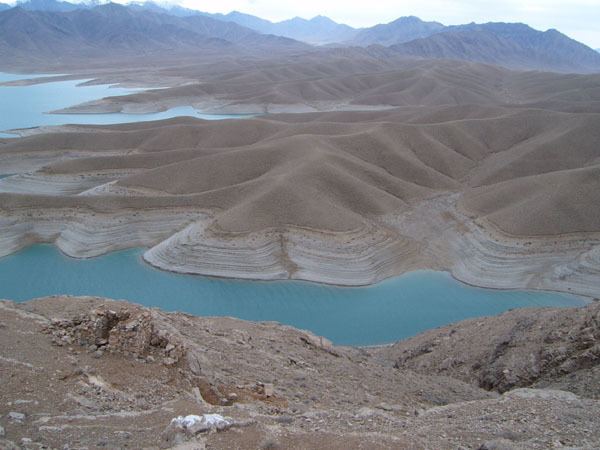River mouth Lake Hamun Length 1,150 km | ||
 | ||
Tributaries Left:Arghandab RiverRight:Khash RiverChagay River | ||
The Helmand River (also spelled Helmend, Helmund, Hirmand; Pashto/Persian: هیرمند, هلمند Hīrmand, Helmand, Greek: Ἐτύμανδρος (Etýmandros), Latin: Erymandrus) is the longest river in Afghanistan and the primary watershed for the endorheic Sistan Basin.
Contents
Map of Hirmand, Iran
The name comes from Avestan Haētumant, literally "dammed, having a dam", cognate with Sanskrit Setumanta "having a dam", which referred to the Helmand River and the irrigated areas around it. The name was borrowed into Greek and Latin as a compound with Eastern Iranian *raha (cf. Scythian Rha "Volga"), "river". Helmand Province is named after the river.
Geography
The Helmand River stretches for 1,150 km (710 mi). It rises in the Hindu Kush mountains, about 80 km (50 mi) west of Kabul (34°34′N 68°33′E), passing north of the Unai Pass,in the eastern proximities of Hazarajat, in Behsud, flows west to Daykundi and Uruzgan. It crosses south-west through the desert of Dashti Margo, to the Seistan marshes and the Hamun-i-Helmand lake region around Zabol at the Afghan-Iranian border (31°9′N 61°33′E).
The river remains relatively salt-free for much of its length, unlike most rivers with no outlet to the sea. This river, managed by the Helmand and Arghandab Valley Authority is used extensively for irrigation, although a buildup of mineral salts has decreased its usefulness in watering crops. Its waters are essential for farmers in Afghanistan, but it feeds into Lake Hamun and is also important to farmers in Iran's southeastern Sistan and Baluchistan province.
A number of hydroelectric dams have created artificial reservoirs on some of the Afghanistan's rivers including the Kajakai on the Helmand River. The chief tributary of the Helmand river is the Arghandab River (confluence at 31°27′N 64°23′E) which also has a major dam north of Kandahar.
The boundaries of the province of Helmand were once known as kingdom of Sakastan.
History
The Helmand valley region is mentioned by name in the Avesta (Fargard 1:13) as the Aryan land of Haetumant, one of the early centers of the Zoroastrian faith in pre-Islamic Afghan history. But owing to the preponderance of Hindus and Buddhists (non-Zoroastrians), the Helmand and Kabul regions were also known as "White India" in those days. Sorcery was prevalent in the basin of the Helmend river, and the Parsi were powerful in Cabul, which is a Zoroastrian way of saying that the Hindu civilisation prevailed in those parts, which in fact in the two centuries before and after Christ were known as White India, and remained more Indian than Iranian till the Muslim conquest. The Hindu Zunbils were also located here. Some Vedic scholars (e.g. Kochhar 1999) also believe the Helmand valley corresponds to the Sarasvati area mentioned in the Rig Veda as the homeland for the Indo-Aryan migrations into India, ca. 1500 BC. Six major discoveries by Italian Archaeologist in Swat District of Khyber Pukhtunkhwa Province of Pakistan regarding the river have been discussed in the book The History of Communication (published 2012).
